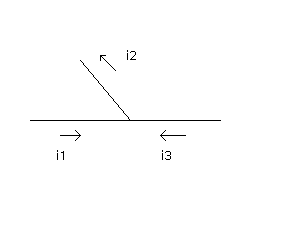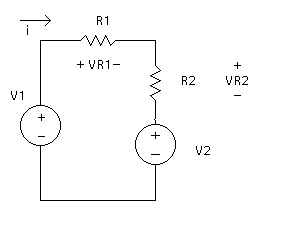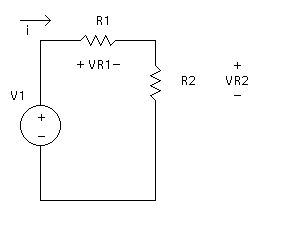EEGR2111 L5
- Resistive Circuits (Chap. 3)
- Circuit topology
- The interconnection of the circuit
- Node: junction of connection between elements
- Closed path (loop): a path through the circuit elements that
passes at most once through any node and returns to the
starting node.
- How many nodes and loops in the above circuit?
- Kirchoff's Current Law
- The ALGEBRAIC sum of currents into a node = 0
- True for any instant of time
- Method: currents directed into node are positive
- Algebraic implies including polarity as labeled
- Below, i1 - i2 + i3 = 0:

- Repeat for currents OUT of node. Explain.
- Basically:
Charge doesnt leave wires
Charge doesnt accumulate ("bunch-up") in wires
- Kirchoff's Voltage Law
- The ALGEBRAIC sum of voltages around a loop = 0
- True for any instant of time
- Algebraic implies including polarity as labeled
- Method: follow the voltage sign of the first terminal encountered while traversing the loop
- Below, VR1 + VR2 + V2 -V1 = 0:

- Repeat, following loop in opposite direction. Explain.
- Example L5-1
- In the above, let R1=5, R2=1, V1=1, V2= -3
- How many nodes? loops?
- What is KCL at the node between the two resistors?
- Write KVL for the loop
- Use Ohms law to substitute for the resistor voltages
- Can we solve for i ? If so what is i ?
- What is VR1? What is VR2 ?
- What is the power absorbed by each of the 4 elements?
- What is the sum of the power absorbed by each of the 4 elements?
- Voltage divider
- The basic voltage divider circuit is:

- By KCL at each node: same current through the single loop
- By KVL: VR1 + VR2 - V = 0
- By Ohms law: VR1 = i R1, VR2 = i R2
- So: V = i (R1 + R2 )
- (What is i for the circuit?)
- Finally:
VR2 / V = ( i R2) / i (R1 + R2) = R2 / (R1 + R2)
- What is the maximum voltage gain (VR2/VR1) ?
- What is the maximum power gain ?





